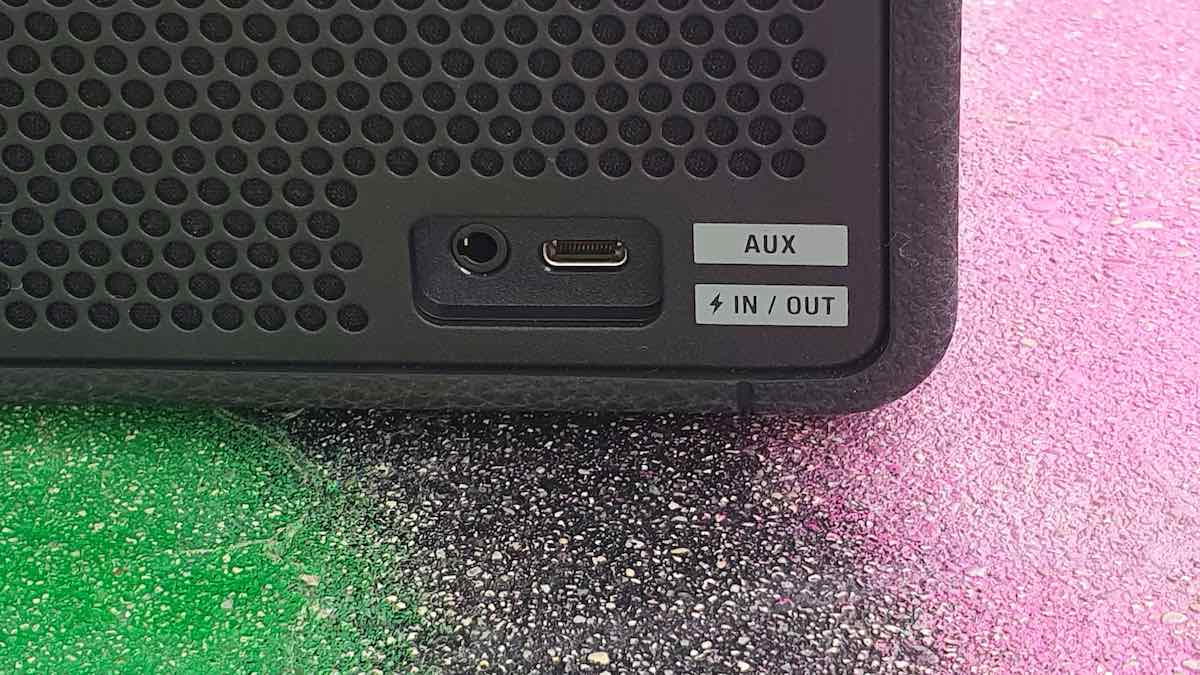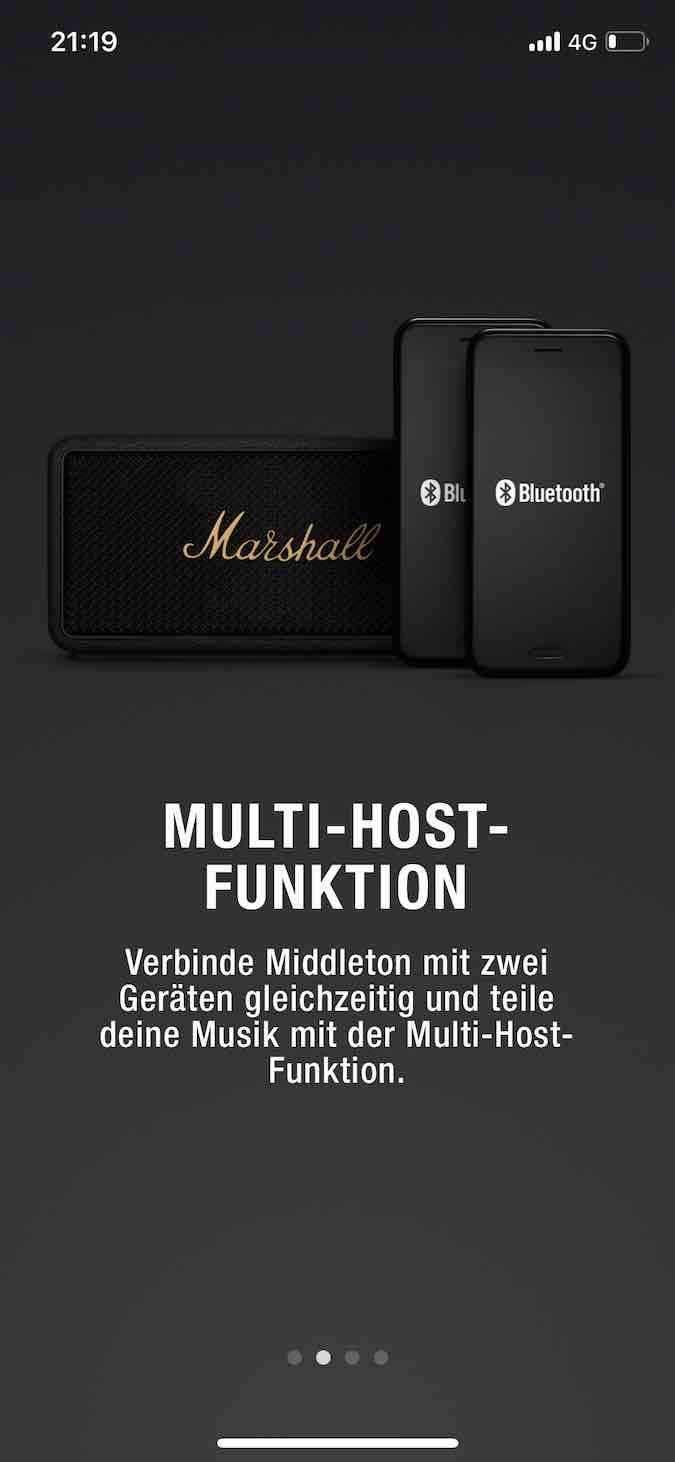STEREO GUIDE Verdict
+ great dynamics, energetic treble
+ well-balanced from literally every angle
+ voluminous deep bass given its size
+ simple, perfect ease-of-use
- Low bass too dominant for indoor, rather boomy
-
Sound: Tonal balance / transparency7.8
-
Sound: Bass / Dynamics7.7
-
Ease-of-use / Connectivity8.8
-
Price / Performance8.8
Start the new year with a big bang! That´s what Zound Industries might have thought when launching their latest Bluetooth model: the Marshall Middleton. We have seen some fireworks of mature and dynamic Bluetooth speakers by the legendary brand and their Scandinavian licensee before. But they were all meant solely for indoor use: Acton III, Stanmore III and Woburn III created a surprising triple-win during our review process. Some fans of the brand may have wished for a portable version with a battery – a larger Marshall Emberton 2, so to speak. That tiny speaker has been the most versatile we have been reviewing so far and did deliver quite a positive surprise in terms of sound quality. Although it is relatively compact and therefore not being created to be the most dynamic one.
So it seems that the latest Middleton is the answer to all these cries: it just felt like an Emberton II derivate having significantly grown. That said, its weight in particular has more than doubled. The rubber carry strap turns out to be accordingly wider. It´s definitely cool to carry it from the subway station to the beach but you might actually feel the weight. So putting it in a backpack seems to be a good idea, and pretty possible thanks to its still compact dimensions and a suitable shap.
Emberton has grown significantly
By the way, the battery life did not increase proportionally with the weight. The Middleton holds a respectable reserve of 20 hours maximum runtime on one charge, but afterwards calls for a whopping 4.5 hours for fully recharging the battery.
There is actually a reason for that: A 4-channel amp inside, sucking quite some current for a total power output of 60 watts. That’s almost double the power compared to the nominally larger Marshall Kilburn II. Given the spec sheet it is promised to not only deliver deep bass and impressive SPL, but also spanning a stereo panorama by implementing 2 separated channels in a true 2-way x-over arrangement each. This said, we found two woofers of an amazing 3 inch in diameter each plus two tiny tweeters ensuring wide directivity pattern. Two large passive compound drivers provide additional low-bass, which is a pretty efficient way to extend the lower bass without sacrificing any watts or enclosure volume for this purpose. And it definitely gives the Middleton a record maximum of diaphragm space in such a small cabinet.
Bluetooth loudspres with quad drive
The 6 drivers are distributed on all four sides in an unusual way. The two mid/woofers are located on either side, front and rear baffle are each occupied by a tweeter plus a compound driver. I.e. right tweeter is located on the right front, the left one on the left rear. Thus, the compact speaker must be positioned horizontally and should get some minimum distance to nearby surfaces in all directions.
Marshall is promising a maximum of sound image width calling this technology “True Stereophonic with multi-directional and immersive sound”. From a home theater enthusiast’s point of view, perhaps a somewhat exaggeratedly bold claim, because we did not find any circuitry neither for virtual surround sound nor phaseshifting filters in the Middleton. Which is rather an advantage when listening to music from a comparably small speaker as too much of phase shifting and virtual stereo often leads to phasy and cancelled-out mids. When using it open-air, the Middleton offers an unparalleled omnidirectional directivity pattern thanks to its drivers on all four sides.





Highest praise for ease-of-use
Some competitors recently seemed to overload their Bluetooth speakers with features. And Marshall´s spec list is growing as well. However, especially with the Middleton, we had the feeling that only really useful and intuitive features were added here and no bells and whistles.
Many music lovers might find the additional analogue jack input useful. You might also want to activate some kind of daisy-chain mode called “stack mode”, to speak more in Marshall language. Really nice: One could activate that without any app. However, you can’t build a true stereo pair out of two Middletons. Naturally, features like app control, powerbank output, multihosting for two smartphones is offered as in all modern portable Marshalls. Bluetooth is state of the art: version 5.1.
Although the Middleton does not offer the retro touch by heritage-like control knobs as its couch potatoe brother Acton III, the brass-coloured joystick-style button for volume and playback control is exemplary when it comes to ease-of-use. Additional buttons for source selection, stack mode as well as bass and treble control are both perfectly useful and intuitive. But the aforementioned on top of the cabinet are definitely less visible, or should we say kind of hidden, so the clean design is left undisturbed. A row of red LEDs is serving as both a battery indicator or volume/treble/bass feedback. We are impressed.




One important feature in the app is missing
The Marshall Bluetooth app for iOS and Android basically doubles all these displays and options, which leaves it largely dispensable in the end. On the Android phone, however, the Bluetooth connection exclusively required an app, and only after quite a few attempts, system updates and dead end links in the Playstore we did it finally manage to synchronize everthingy. By the way, the app left one important wish unfulfilled, but we will get to that in a suitable place in the listening test.
Waterproof, dustproof, sustainable
The Middleton’s IP67 rating means an impressive 30 minutes timeframe of fishing it out of the water from the moment of submerging it ( one meter in depth is the limit altough). And it is really dustproof which is in combination more than you´d ever need at the beach.
Especially since the Middleton with its sturdy but finger-flattering soft case in leather look and rounded edges also seems to be quite resistant. By the way, nostalgic retro looks do not stand in the way of sustainability: The manufacturer promises a 55% recycling rate for the casing material and does not use any PVC at all. We got it: This material should be strictly reserved for vinyl records, in case there’s ever a shortage.
Sound quality estimation of Marshall Middleton
With a brief electric guitar riff, the Marshall confirms a completed Bluetooth connection. During our extended listening tests in different environments, we quickly got the feeling that we had two systems showing a completely different behaviour depending on where it was positioned: Marshall´s Middleton was a rock-solid solution when used open-air. Dynamic, lively, rich, deep bass and astonishing SPL capabilities given its size. It also delivered a combination of gripping, speedy and impulsive sound characteristics with exemplarily perfect omnidirectional sound no matter if you were listening in front or behind it.
We particularly liked the voicing of mids and treble: Voices sounded tonally balanced and well-defined, but still offering a lot of clarity and articulation, as you would expect it when listening to rock, pop or hiphop. For all its tendency towards popular music, the Middleton´s sound never got sharp and delivered a really clean and well-defined mix. Even when he had to play several voices, brass or saxophones.
No shortage of bass, indeed
In terms of bass capabilities it is amazingly voluminous considering its size: really deep, rich and loud, beats were pumping as if it the speaker had double or triple its volume. The fact that the bass sometimes seemed a bit dominant and couldn’t always keep up with the subjective speed of the mids and trebles shouldn’t bother anyone on the beach or in the park. Especially classic rock, 1970s disco and alike sounded astonishing and with impressive bass. With modern electronic beats, on the other hand, it could be too much going round in the very low-end, as sharp transients sometimes got lost a bit in this sonic thunderstorm.
However, this turned out to be a downside inside a room, particularly smaller ones: In the bass region, a narrow frequency band appeared to be pretty dominant and with some tracks even covered the rest of the audible range. We found examples driving the bass to appear somewhat overly fat or even boomy, which was simply too much of a good thing, especially when placed close to the wall. By the way, using the bass control did not help, but even widened the frequency gap between the sheer mass of low bass and the mid/treble regions, occasionally intensifying the effect.
It’s a pity, because otherwise the Middleton would have cut a good figure indoors as well. In smaller rooms and when sitting directly in front of it, you don’t notice much of the stereo panorama, but all the more of its gripping dynamics and directness. However, in larger rooms, especially when the Marshall was placed on a table close to a corner, it provided a reasonably wide sound image and ambience.
No so easy to tame
Unfortunately, experience has shown that the booming effect got even more audible with corner placement. The rear left tweeter, on the other hand, makes it a gamble on a bookshelf or placed directly next to the wall. Thus, we can seriously recommend it only for mobile applications. But all the more emphatically. A remedy would be within reach: For home speakers like the Woburn 3, the Marshall Bluetooth app offers an easy-to-use “Placement Control”, which allows this particular Bluetooth speaker offering a pretty hefty bass as well, to be well adjusted to the sonic position. But as it is in the meantime: Today is not every day, maybe a future update will bring it if many users join our opinion after the launch.
Alternatives to the Marshall Middleton
A lot of technology inside, convincing exterior, compact dimensions and a fully convincing dynami, mature sound – in its size class, the Marshall Middleton clears for outdoor use. For that, it costs a few bucks more than potential competitors like Aiwa´s Exos-3 or the Dockin´s D Fine 2. Both reach the overall sonic standard of the Marshall. But they are larger and heavier and offering less of charmingly impulsive sound and comparably wide sweet spot. So if money is no object and maximum bass out of minimum enclosure is the way to go – the Middleton is the device you might want to go for.
On the other hand, using it equally on the go and indoors is a different story: Sony´s SRS-XG300 offering a much dryer bass might not sound quite as spectacular for hip-hop fans and is surely not as lightweight. But it is hardly causing any acoustical problems in the bass when interacting with a small or medium-sized room. There is one exception: if you live in an environment solely surround by drywall construction or under the roof – it might help to absorb enough bass to make the Middleton an indoor champion as well.
Specifications: Marshall Middleton
- Retail Price: 300 Dollars/Pounds/Euros approx.
- Dimensions (W x H x D): 23 x 11 x 9.5 cm
- Weight: 1.8 kg
- Battery life up to 20 hours
- Features: IP67 water and dust protection, Marshall Bluetooth app, stack mode, multi-host with two smartphones, in black or beige.
- More at: www.marshallheadphones.com








